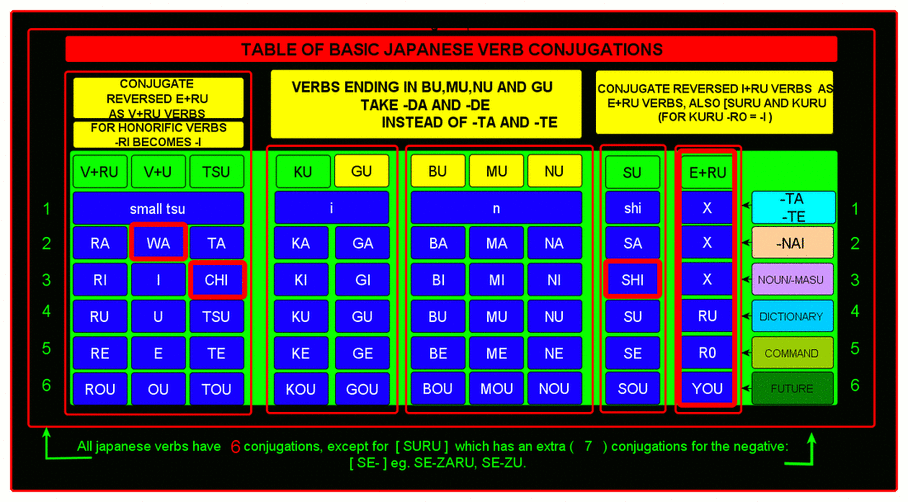LEVEL 3
In LEVEL 1 we learned to distinguish from which verb group a given Japanese verb belongs to and in LEVEL 2 we learned whether a given verb takes a "small tsu", i, n, shi, or X, in their "TA/TE" forms.
In LEVEL 3, we will be applying the skills we adquired in LEVELS 1 and 2, and we will develop accuracy and speed in using all 6 basic Japanese verb conjugations for all verbs.
When you click START, you will be presented with a Japanese verb (target verb) and it's Englsih translation.
(See image below inside red oval)
(NOTE: Always double-check what level your present drills is from. Inside yellow circle)
In LEVEL 1 we learned to distinguish from which verb group a given Japanese verb belongs to and in LEVEL 2 we learned whether a given verb takes a "small tsu", i, n, shi, or X, in their "TA/TE" forms.
In LEVEL 3, we will be applying the skills we adquired in LEVELS 1 and 2, and we will develop accuracy and speed in using all 6 basic Japanese verb conjugations for all verbs.
When you click START, you will be presented with a Japanese verb (target verb) and it's Englsih translation.
(See image below inside red oval)
(NOTE: Always double-check what level your present drills is from. Inside yellow circle)
Your goal is to provide, 1 by 1, the 7 basic conjugations of the target verb.
(Same order as below)
Example.
Target verb "noru koto" (to ride) (see screen shots below)
(drill)1. rode (past conjuagtion "-TA")
(correct answer) notta
(drill)2. riding (progessive conjugation "-TE" conjugation)
(correct answer) notte
(drill)3. doesn't ride (negative conjugation)
(correct answer) noranai
(drill)4.rides (polite) (only use polite form when indicated to do so, otherwise use plain forms)
(correct answer) norimasu
(drill)5.ride (plain) (dictionary conjugation)
(correct answer) noru
(drill)6.(you) ride! (command conjugation)
(correct answer) nore
(drill)7. will ride (future conjugation)
(Some people call it the "volitional". potatoes, patatas! Future is just a friendlier word!)
(correct answer) norou
Tips: first ask yourself,
1. what groups does this verb belong to?
(VRU? VU? TSU? KUGU? BUMUNU? SU? ERU? REV? IRREGULAR? HONORIFIC?)
2. What does it take in it's "-TA/-TE" forms, a "small tsu? an "i"?, "n"?, "shi"? "X"?
3. Answer the first 2 drills "TA and TE"
4. Answer the rest of the drills by replacing the last syllable of the target verb to match the "TABLE OF BASIC JAPANESE VERB CONJUGATIONS".
In the above example, the last syllable of NORU ,"-RU", was replaced by "t"(ta), "t"(te), "ra"(nai), "ri"(masu), "ru"(dict), "re"(command), "rou"(future)
Do the same according to the target verb.
Let's look at the screenshots below.
(Same order as below)
Example.
Target verb "noru koto" (to ride) (see screen shots below)
(drill)1. rode (past conjuagtion "-TA")
(correct answer) notta
(drill)2. riding (progessive conjugation "-TE" conjugation)
(correct answer) notte
(drill)3. doesn't ride (negative conjugation)
(correct answer) noranai
(drill)4.rides (polite) (only use polite form when indicated to do so, otherwise use plain forms)
(correct answer) norimasu
(drill)5.ride (plain) (dictionary conjugation)
(correct answer) noru
(drill)6.(you) ride! (command conjugation)
(correct answer) nore
(drill)7. will ride (future conjugation)
(Some people call it the "volitional". potatoes, patatas! Future is just a friendlier word!)
(correct answer) norou
Tips: first ask yourself,
1. what groups does this verb belong to?
(VRU? VU? TSU? KUGU? BUMUNU? SU? ERU? REV? IRREGULAR? HONORIFIC?)
2. What does it take in it's "-TA/-TE" forms, a "small tsu? an "i"?, "n"?, "shi"? "X"?
3. Answer the first 2 drills "TA and TE"
4. Answer the rest of the drills by replacing the last syllable of the target verb to match the "TABLE OF BASIC JAPANESE VERB CONJUGATIONS".
In the above example, the last syllable of NORU ,"-RU", was replaced by "t"(ta), "t"(te), "ra"(nai), "ri"(masu), "ru"(dict), "re"(command), "rou"(future)
Do the same according to the target verb.
Let's look at the screenshots below.
The drill is asking me to enter the equivalent of "rode" in japanese; so, I type in "notta" and click enter.
That takes me me to my next drill.
In this case I accidentally ended up pressing "enter" too many times, and as a result,
I ended up skipping conjugations 2,3,4,5 and 6!
That takes me me to my next drill.
In this case I accidentally ended up pressing "enter" too many times, and as a result,
I ended up skipping conjugations 2,3,4,5 and 6!
If we look at the RESULTS PANEL above, we can see what happens when the answer doesn't match the sensei's answer.
My first answer "notta" matched the sensei's answer so I got 10 points.
But i didn't etner anything for drills 2,3,4,5 and 6 so I got -10 points each! This might seem a bit harsh, but the idea is to encourage you to concentrate as much as possible; just like you would in any game!
My last answer "norou", also matched the sensei's; so, I got ten points.
AT the bottom left of the RESULTS PANEL we can see what my score was for this drill.
I got -30 points.
The idea is that, in a reallife scenario, you don't want to make that many misakes, specially if your are taking a test or attending a business meeting or job interview!
So, this game/learning app encourages you to concentrate in order to minimize your mistakes which in turn will boost your performance!
watch video for level 3





